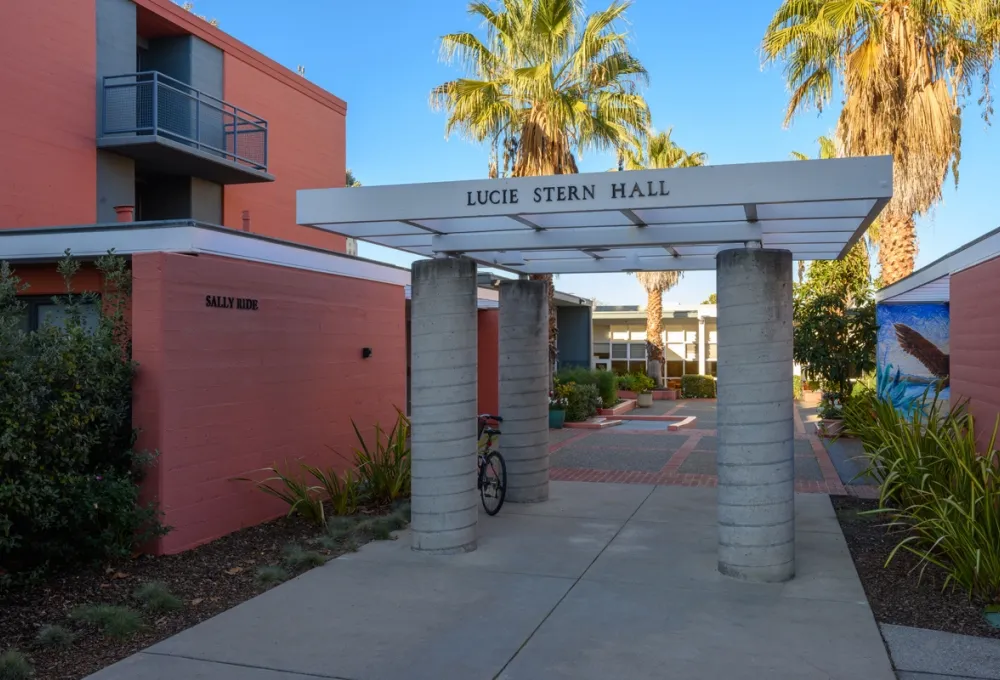Table of Contents
It’s happened to every Stanford student: there’s a knock on the front door of your dorm. As usual, someone lacks keycard access, and they seem harmless enough, so you let them in.
But two weeks ago, the knocker was a bald, middle-aged, homeless man banging on the doors of Sally Ride house at six in the morning. Eventually, students gave in and opened the door.
This unidentified individual went on to take showers on two separate floors, splashing water across the floor and using residents’ toiletries. (Afterward, one student wrote in a group chat: “Third floor bathroom is absolutely FOUL [sic] can [we] request emergency cleaning.”) Wearing nothing more than a towel, he wandered the dorm for four hours before an RA asked him to leave.
He was later found by the Department of Public Safety, which issued him a warning that the dorm RAs forwarded to residents (pictured below). The RAs’ initial response was entirely reasonable, reminding residents to avoid letting strangers into the building and alert staff immediately when such situations arise.

A dorm-wide meeting convened that night to discuss the situation further, taking on the semblance of a therapy session as RAs acknowledged that the individual’s intrusion was “disrespectful,” “uncomfortable,” and even “traumatic.” RAs encouraged students to share their feelings about the intrusion with the group, an RA, or CAPS (Counseling and Psychological Services).
And yet, immediately after encouraging students to take steps to avoid such incidents in the future, the RAs launched into a plethora of mixed messages that thoroughly contradicted their initial (and entirely appropriate) reaction. They apologized repeatedly for the “criminalizing” tone of the initial email without specifying what about the message was so “criminalizing”. They also cautioned against “false reporting of innocent individuals” (never mind the fact that students had done quite the opposite).
A resident faculty member (RF) then recalled an anecdote from a few years ago in which security was called on a ‘suspicious’ African-American man trying to enter a dorm, and he turned out to be the father of a student. (The Review was unable to corroborate this account.) That situation, the RF explained, was proof of how easily students could become complicit in racial profiling. But to call this a false equivalency would be an understatement. This individual was white, but more importantly, when a nearly naked man trespasses in a college dorm, his race is irrelevant.
And the meeting wasn’t over yet. The conversation then turned to homelessness at large. Well, not homelessness, but “houselessness” – because, as RAs explained in a later email also signed by the RFs, “a home is not necessarily a place or structure.” Next came a series of musings on the causes of homelessness that made it abundantly clear why policymaking isn’t part of the RA job description:
While many of [the unidentified individual’s] actions were disturbing and disrespectful, rates of houselessness are incredibly high in the Bay Area where the expansion of wealth in the tech industry has spurred massive inequality. Many individuals who are houseless are looking for a place to sleep, a hot meal, and a warm shower. A lot of the time, their intention is not to harm, and their current condition is usually caused by poor economic conditions that result from very little to no fault of their own.
This account is oversimplified, to say the least. The causes of homelessness extend beyond economic hardship, including substance abuse and mental illness (which this individual appeared to be experiencing – especially given that students observed him peering into first-floor windows for days prior). Empathetic discussions about housing issues are entirely worth having, but this particular conversation veered dangerously close to rationalizing a potentially dangerous individual’s trespassing.
Ultimately, this combination of a reasonable reaction to a troubling incident and the compulsive addition of social justice doctrine resulted in a confusing double bind. Students must be vigilant, lest they risk traumatizing their entire dorm, but they should avoid being too vigilant, lest they be labeled racist or unsympathetic to a problem for which they are at fault.
Let’s not make this too complicated. In the future, we should refrain from obliging middle-aged people who bang on the door of an undergraduate dorm at 6 AM, report such events immediately, and make use of Stanford’s public safety infrastructure. By all means, let’s also discuss and take action on serious issues of public policy such as homelessness. But to make dorms a welcoming environment for all students, staffers need to stop pushing political agendas and start paying more attention to real danger.





